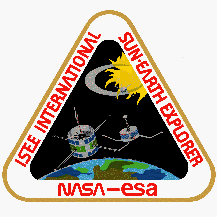
International Sun-Earth Explorer (ISEE) Program
The ISEE program consisted of three spacecraft, ISEE-1 and ISEE-3 which were
the principal U.S. contributions to the International Magnetospheric Study, and
ISEE-2 which was built and managed by the European Space Agency (ESA). ISEE-1
and ISEE-2 launched on October 22, 1977, were in almost coincident orbits
around the earth with periods of approximately 57 hours, and their time
separation in this orbit could be altered by maneuvering ISEE-2. ISEE-3 was
launched on August 12, 1978, and inserted into a "halo orbit" about the
libration point situated ~240 earth radii (Re) upstream between the earth and
the sun. Plasma passing this point arrives at the earth approximately 1 h later
where it may cause changes which can be observed by instruments on ISEE-1 and
ISEE-2. These two spacecraft, separated by a variable distance and with similar
instrument complements, were able to break the space-time ambiguity inevitably
associated with measurements by a single spacecraft on thin boundaries which
may be in motion, such as the bow shock and the magnetopause. Apogee of the
ISEE-1 and ISEE-2 orbit was 23 Re, so the spacecraft penetrated into the
interplanetary medium for up to 3/4 of an orbital period depending upon the
time of year. The ISEE-1 and ISEE-2 spacecraft reentered the Earth's atmosphere
in September 1987 after 1517 orbits of the Earth. ISEE-3 was taken out of it
libration point orbit in the summer of 1983 and after a series of deep passes
down the magnetotail, left the gravitational influence of the Earth and passed
by comet Giacobini-Zinner in September 1985.
Adaped from http://www-ssc.igpp.ucla.edu/ssc/isee.html
